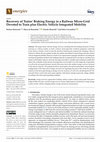Papers by Fabio Crescimbini

2020 IEEE Energy Conversion Congress and Exposition (ECCE)
Today, for several economic and environmental reasons, Electric Vehicles (EVs) have a notable imp... more Today, for several economic and environmental reasons, Electric Vehicles (EVs) have a notable impact over the automobile world market. Accordingly, the amount of charging stations with reduced charge time is increased. The design aspects and the realization of the isolated Four-Port bidirectional Dual Active Bridge DC-DC Converter (4P-DAB) for fast charging applications are described in this paper. The 4P-DAB can handle different sources and loads thanks to the connection between four full bridges to the four windings of the high-frequency (HF) transformer. The design procedure and the power devices selection are carried out. The conversion efficiency as a function of the output power for different control strategies is presented using the Silicon-Carbide (SiC) power semiconductors. Simulation and preliminary results are verified by realizing the switching model of the 100 kVA 4P-DAB in MATLAB/Simulink.
Vigo, Spain, 10-12 settembre 199

1998 International Conference on Power Electronic Drives and Energy Systems for Industrial Growth, 1998. Proceedings.
The paper outlines the original solutions adopted for powering an original three-wheel electric v... more The paper outlines the original solutions adopted for powering an original three-wheel electric vehicle. This is a lightweight vehicle for use in the urban mobility with mission tasks such as 50 km/h cruising speed and 80 km range of autonomy. The propulsion system is based on a lead-acid battery fed wheel direct drive. This is arranged with a 4.5 kW prototype of slotless axial-flux permanent magnet machine which has total weight of 15 kg and is capable of 85 Nm continuous torque and 120 Nm peak torque over 2 min. The motor is totally enclosed in the single front wheel of the vehicle and fed through an IGBT bidirectional power converter which allows the control of both motoring and regenerative braking operations. Design characteristics and experimental data taken from the prototype of wheel direct drive are given in the paper.

Energies, 2022
This paper deals with the energy recovery resulting from the braking transient of trains arriving... more This paper deals with the energy recovery resulting from the braking transient of trains arriving in a railway station, to feed a railway micro-grid that would be purposely connected to the railway traction circuit to feed the electrical infrastructure required for charging a fleet of electrical vehicles that are parked nearby the station and offered for providing train plus electric vehicle integrated mobility. Based on results of an experimental campaign intended to recording the mechanical quantities related to the braking transient of regional trains arriving in a medium-size station of the Italian railways network, this paper describes a suitable quasi-stationary model that allows the evaluation of the amount of energy that is recoverable over each single day of operation, as well as the micro-grid dynamic electric behaviour due to the sudden energy recovery transient in the railway catenary. The proposed railway micro-grid is discussed, particularly concerning the configuratio...
2017 IEEE International Symposium on Sensorless Control for Electrical Drives (SLED), 2017
1Simple adaptations of the latest design ideas in [2] suggest the existence of a new observer to ... more 1Simple adaptations of the latest design ideas in [2] suggest the existence of a new observer to be used for sensorless speed control of (nonsalient-pole surface) permanent magnets synchronous machines. The rotor speed measurement-assumed to be measured in [2] by a low-resolution transducer providing a single pulse per revolution — is here replaced by the output of a PLL (Phase Locked Loop) block that is based on a third-order Steady-State Linear Kalman Filter (SSLKF). Experimental results concerning the new observer are provided.

2020 IEEE Energy Conversion Congress and Exposition (ECCE), 2020
Today, for several economic and environmental reasons, Electric Vehicles (EVs) have a notable imp... more Today, for several economic and environmental reasons, Electric Vehicles (EVs) have a notable impact over the automobile world market. Accordingly, the amount of charging stations with reduced charge time is increased. The design aspects and the realization of the isolated Four-Port bidirectional Dual Active Bridge DC-DC Converter (4P-DAB) for fast charging applications are described in this paper. The 4P-DAB can handle different sources and loads thanks to the connection between four full bridges to the four windings of the high-frequency (HF) transformer. The design procedure and the power devices selection are carried out. The conversion efficiency as a function of the output power for different control strategies is presented using the Silicon-Carbide (SiC) power semiconductors. Simulation and preliminary results are verified by realizing the switching model of the 100 kVA 4P-DAB in MATLAB/Simulink.
This paper presents an axial-flux induction motor which has a single stator and two squirrel-cage... more This paper presents an axial-flux induction motor which has a single stator and two squirrel-cage rotors mounted on individual, independents shafts driving two wheels of an electric vehicle. This novel induction machine inherently behaves as an electromagnetic differential motor and thereby performs the function of both the engine and the differential of a conventional vehicle. Features of the proposed motor topology are described, and an equivalent circuit is derived from the analysis of the magnetic and electrical behaviour of the machine. Basic machine design and characteristics of a 20 kW motor prototype are finally discussed

2020 IEEE Energy Conversion Congress and Exposition (ECCE), 2020
This paper focuses on the modelling of the current ripple in a Power-Hardware-in-the-Loop (PHIL) ... more This paper focuses on the modelling of the current ripple in a Power-Hardware-in-the-Loop (PHIL) emulator of an isotropic Permanent Magnet Synchronous Machine (PMSM). In such applications, one of the main challenges is to replicate the current behavior when the inductance that is installed in the PHIL differs from that of the emulated machine. This is because the power emulator must emulate the current ripple at the switching frequency of the Device Under Test (DUT). A theoretical analysis is carried on deriving the equations that describe the current waveform in the PHIL. An expression for the current error between the PHIL system and the emulated one is derived and the parameters that affect the error are highlighted. Mathematical expressions for the control actions needed to bring the current error to zero are proposed and the technical limitations in their application are discussed. Simulation results confirm the effectiveness of the proposed analysis.

2021 23rd European Conference on Power Electronics and Applications (EPE'21 ECCE Europe), 2021
This paper proposes a 3-Phase 5-Level Multicell E-Type Converter (3Φ5L ME-Type) for medium-voltag... more This paper proposes a 3-Phase 5-Level Multicell E-Type Converter (3Φ5L ME-Type) for medium-voltage applications. The proposed converter has each phase being accomplished by the combination of two I-Type cells connected to the Neutral Point Clamped (NPC) cell. The 3Φ5L ME-Type topology can improve the voltage stress of the power semiconductors, allowing to increase the DC-bus voltage. Operation modes and characteristics of the proposed converter are presented, and the theoretical investigation has been validated through the realized model in the Hardware-In-the-Loop (HIL) test bench. The performance of the proposed converter has been estimated through the created thermal model in Plexim/PLECS environment of the selected power semiconductors. The results show good performance and the effectiveness of the proposed converter to reduce the power semiconductor voltage stress compared to the previously E-Type Topology.

2020 International Symposium on Power Electronics, Electrical Drives, Automation and Motion (SPEEDAM), 2020
Today, in the railway sector there is considerable interest in studying the best ways for recover... more Today, in the railway sector there is considerable interest in studying the best ways for recovering the electrical energy resulting from train braking as it may allow significant energy saving and better management of the railways grid voltage. This paper presents the results of a feasibility study that has been developed in order to sizing both power electronics and energy storage system that could be arranged in the railways AC/DC substations for recovering the train braking energy in 3 kV DC railway systems. Based on the evaluation of the recoverable energy during one day of operation in a given railway station, the paper discusses a suitable configuration for a braking energy recovery system that could be used to feed two associated electrical utilities, such as an electric vehicles charging station and the electrical distribution circuits of the railway station. According to available experimental data concerning the braking transient of a number of train arrangements, a suita...
Number of electric vehicles (EVs) continues to expand rapidly. This leads to significantly increa... more Number of electric vehicles (EVs) continues to expand rapidly. This leads to significantly increase the amount of charging stations with reduced charge time. This paper focuses on design and realization of the isolated Four-Port bidirectional Dual Active Bridge DC-DC Converter (4P-DAB) to be used in fast charging applications. Each port of the 4P-DAB can manage different sources and loads thanks to the full bridge converter. A magnetic node is created connecting all the ports through a high-frequency multi-winding transformer. The efficiency conversion as a function of the output power has been carried out using Silicon-Carbide (SiC) power semiconductors. Different control strategies have been applied to improve the performance of the converter. Simulation and optimization results are verified by realizing the switching model of 100 kVA 4P-DAB in MATLAB/Simulink.
2020 IEEE Energy Conversion Congress and Exposition (ECCE)
This paper describes the design and the optimization of the Interleaved 3-Phase 5-Level E-Type Ba... more This paper describes the design and the optimization of the Interleaved 3-Phase 5-Level E-Type Back-to-Back Converter (I-3Φ5L BTB E-Type Converter). In the proposed converter, the AC-AC conversion is developed through two parallel 5-level E-Type legs using intercell transformers. A brief introduction to the characteristics of the I-3Φ5L BTB E-Type Converter is given, the general analysis and the design optimization are presented. Furthermore, the hardware realization of the 20 kW 3Φ5L BTB E-Type Converter prototype is discussed, striving for the highest possible efficiency. The converter prototype is characterized by the total weight of 6.18 kg and the power density of 8.4kW/dm3. The experimental results validate the presented theoretical analysis.
The availability of new high-energy permanent magnets at a reasonable cost has opened up the poss... more The availability of new high-energy permanent magnets at a reasonable cost has opened up the possibility of developing very compact brushless permanent magnet motors with substantially improved overload capability for wheel direct drive applications. Concerning the development of an electric propulsion system for a newly-conceived dual-power city car, this paper discusses the design, construction and laboratory testing of a twin wheel direct drive prototype based on a novel topology of water-cooled axial-flux permanent magnet motor.

An axial-flux permanent magnet machine (AFPM) topology with a coreless winding is proposed for ge... more An axial-flux permanent magnet machine (AFPM) topology with a coreless winding is proposed for generator units required aboard ships, aircraft or hybrid-electric vehicles. In the proposed AFPM configuration, the winding consists of rhomboidal shaped coils encapsulated in fibre-reinforced epoxy resin. The coils have a double-layer arrangement to leave space for a cooling water duct being used to remove heat directly from the interior surface of the winding. The overall machine structure has high compactness and lightness, and because of the lack of the iron core generator operation with power output at 400 Hz can be accomplished with high efficiency and acceptable voltage regulation. The paper discusses the basic design and construction of AFPM generators with coreless winding and experimental results taken from a 16 poles machine prototype rated 70 kW, 3000 rev/min are finally reported.
A master-slave synchronization control problem is addressed for current-fed permanent magnets syn... more A master-slave synchronization control problem is addressed for current-fed permanent magnets synchronous machines with uncertain parameters and no speed sensor. An exogenous rotor position reference signal, which belongs to the class of biased sinusoidal signals with uncertain bias, amplitude, angular frequency, phase, is to be tracked without assuming its foreknowledge. An innovative output feedback adaptive nonlinear control scheme, which solves the aforementioned problem and simply generalizes the classical internal model-based input law, is presented. The effectiveness of the proposed approach is validated by experimental results.
2021 IEEE Energy Conversion Congress and Exposition (ECCE)








Uploads
Papers by Fabio Crescimbini